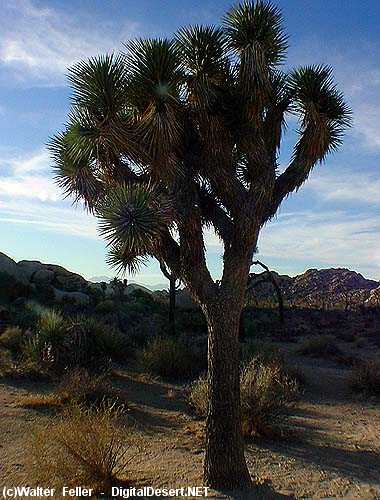Joshua Tree - Tree of Life
The Joshua tree, (yucca brevifolia), grows wild primarily in the Mojave Desert. It has adapted to reduced rainfall by spreading its roots in a dense, shallow network to collect as much surface moisture as possible.Almost every part of this plant has been or is used by other desert dwellers, people as well as the animals. Chemehuevi indians wove its fibers to make baskets, sandals, and mats.
Scott's orioles can sometimes be seen near woven nests hanging beneath tree limbs. Watch for ladder-backed woodpeckers or flickers flying in and out of holes they drill in the tree trunks.
Rock squirrels, birds, and mule deer eat the creamy white blossoms. Later fruits and seeds provide food for antelope ground squirrels and other small animals. Even after death, a tree trunk on the ground provides a home for desert night lizards, ants, and scorpions. Eventually, termites return it to the desert enriching the sandy soil for the next Joshua tree sprout.
< Previous - Next >

Joshua tree - Tree of life
| Intro:: Nature:: Geography & Maps:: Parks & Preserves:: Points of Interest:: Ghosts & Gold:: Communities:: Roads & Trails:: People & History:: Essays:: Weather:: :?:: glossary |
|
Digital-Desert :
Mojave Desert
|
|
Country Life Realty Wrightwood, Ca. |
Mountain Hardware Wrightwood, Ca. |
Canyon Cartography |
G.A. Mercantile |
Grizzly Cafe Family Dining |
|
Abraxas Engineering privacy |
Disclaimer: Some portions of this project were developed with assistance from AI tools to help reconstruct historical contexts and fill informational gaps. All materials have been reviewed and fact-checked to ensure accuracy and reliability, though complete precision cannot be guaranteed. The aim is to provide dependable starting points and distinctive perspectives for further study, exploration, and research. These materials are historical in nature and intended for educational use only; they are not designed as travel guides or planning resources. Copyright - Walter Feller. 1995-2025. All rights reserved. |